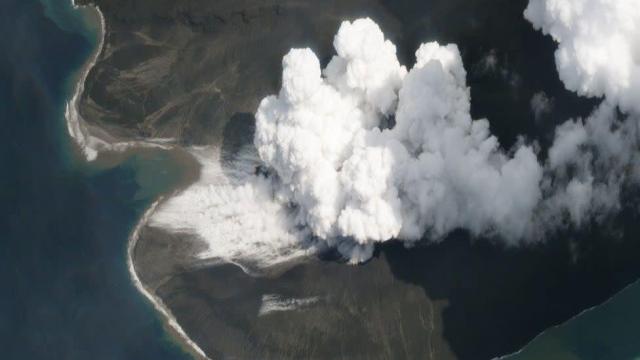The eruption of Anak Krakatoa in 2018 produced a tsunami that, for a short while, was somewhere between 100 to 149 metres tall, according to new research. Had the Indonesian shoreline been closer to the volcano, this disaster would’ve been much worse.
When Anak Krakatoa erupted on December 22, 2018, it caused a dangerous tsunami in Indonesia’s Sunda Strait. Around an hour after the eruption, waves reaching between 5 to 13 meters tall smashed into the nearby coasts of Java and Sumatra, plunging inland to as far as 330 meters in some places. The tsunami caught residents completely off guard, resulting in the deaths of 427 people.
As for the size of the tsunami in the moments immediately following the landslide, that’s been less clear. New research published this week in Ocean Engineering is adding new colour to this rare event, showing that the tsunami, during its first several minutes of existence, was absolutely monumental in size.
Computer simulations of the tsunami suggest the initial wave was somewhere between 100 to 150 metres tall. The new research, led by Mohammad Heidarzadeh, an assistant professor of civil engineering at Brunel University, shows the disaster could have been much worse had the Indonesian coast been situated closer to the Anak Krakatoa volcano.
A wave of this height make a lot of sense given how much material was lost during the eruption. Pics of Anak Krakatoa after the ensuing landslide show the volcano missing an entire side. Somewhere between 150 to 170 million cubic metres of the mountain entered into the water.
“When volcanic materials fall into the sea they cause displacement of the water surface,” said Heidarzadeh in a press release. “Similar to throwing a stone into a bathtub”it causes waves and displaces the water. In the case of Anak Krakatoa, the height of the water displacement caused by the volcano materials was over 100 [metres].”
Heidarzadeh and his colleagues used computer models to simulate the size of the tsunami. They also used sea-level data gathered from five different locations near the volcano to validate the simulations. The best model pointed to a peak intensity lasting for around 6 to 9 minutes after the eruption, at which time the tsunami was generating energy equal to magnitude 6.0 earthquake.
The wave quickly dissipated owing to the combined effects of gravity and friction. As gravity pulled the bulk of water downwards, it created added friction along the seafloor. The wave shrunk considerably, but it still wreaked havoc when it eventually hit Java and Sumatra.
That said, the tsunami was still 80 meters tall when it struck an uninhabited island a few kilometers away from Anak Krakatoa. Had a hypothetical landmass existed at a distance of about 5 kilometres from the volcano, it would’ve been struck by a wave reaching somewhere between 50 to 70 metres, according to the research.
Looking ahead, Heidarzadeh has plans to work with the Indonesian Institute of Sciences (LIPI) and the Agency for the Assessment and Application of Technology (BPPT) to develop a new tsunami response plan for the region.
Anak Krakatoa has a history of inflicting misery. In 1883, an eruption generated a tsunami around 42 metres tall when it hit the coast, resulting in 36,000 deaths”a time when the region’s coastal areas were far less populated.
